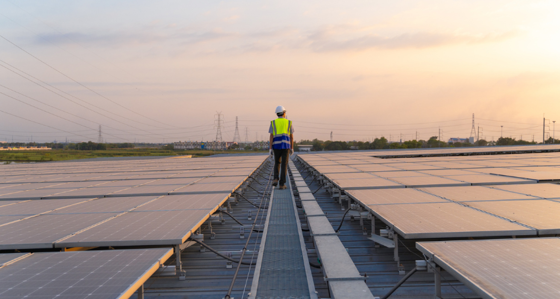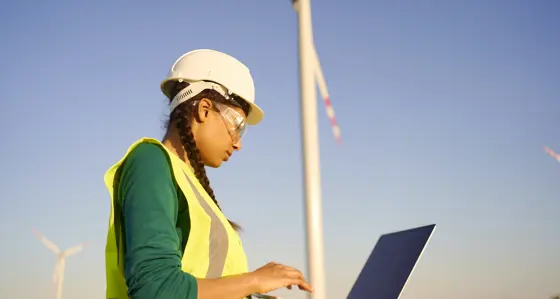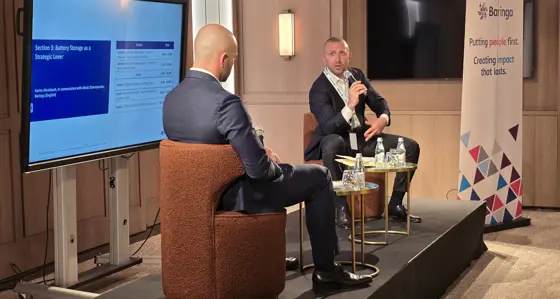
An introduction to the push for carbon neutrality in liquefied natural gas shipping
11 November 2021
The Liquefied Natural Gas (LNG) supply chain is a vast end-to-end operation encompassing a wide range of stakeholders: Production. Liquefaction. Storage. Voyage. Regasification. Transmission. Throw a variety of incoterms into the mix and the assignment of responsibility for emissions across the chain becomes nearly impossible. Through carbon offset schemes, trading companies are beginning to negate the emissions resulting from their operations. They can offset the emissions resulting from a particular section of the supply chain, for example downstream, or the whole supply chain – production, transportation and transmission.
The demand for clean, carbon-neutral LNG has increased and is expected to keep rising as the four largest LNG markets – China, the EU, Japan and South Korea – all introduced carbon-neutrality aspirations in 2020. With the heightened pressure of climate change, a third of LNG buyers anticipate emissions-intensity clauses to be common in contracts.
There are two main approaches when it comes to the idea of ‘clean’ LNG:
- Negation of emissions through carbon offsets.
- Improvement of the associated infrastructure (i.e., vessels).
Carbon emissions portfolio and offsets
Carbon offsets are currently the most common approach to reducing emissions across the LNG supply chain. The process involves the offsetting of emissions created by reducing them elsewhere – via reforestation or environmental projects.
To effectively offset or reduce emissions, stakeholders need to be aware of the emissions that are created because of their activities. To aid this awareness and accountability, the Greenhouse Gas Protocol (GGP) accounting standard can be used.
| Scope | Definition | Example |
| Scope 1 | Direct emissions from owned or controlled infrastructure | Emissions from a vessel, owned by the seller, utilised to deliver a DAP contract |
| Scope 2 | Indirect emissions from the generation of procured energy | Emissions created to generate the electricity the seller buys for its own use |
| Scope 3 | Indirect emissions that occur in a company’s value chain | Emissions resulting from combustion of the regasified LNG by the buyer |
Understanding which scope a company’s emissions fall within as part of their end-to-end supply chain allows them to take vital steps in the transition to a low-carbon economy. Financial institutions are increasingly using these definitions to analyse their clients’ climate risk portfolios and in turn tailoring the products and services available to them. If a company’s risk profile does not align to the Paris Agreement (to limit global warming to under 2°C by the end of the century), they could be incentivised to reduce emissions via lower lending rates.
An increased understanding of emissions profiles requires collaboration. As of 2022, Cheniere plans to provide its LNG customers with the emissions data associated with the production of the LNG purchased. The so-called cargo emissions tags (CE tags) will provide transparency to Cheniere’s customers as well as customers further down the supply chain. Such transparency creates accountability for Cheniere but it also allows other stakeholders to analyse and improve the emissions intensity associated with their own supply chain.
The understanding of a company’s complete emissions portfolio will be crucial if emissions trading schemes (ETS) are widely adopted. In an ETS, the government allocates a certain number of emissions units to companies in each sector and decides what emissions they are liable for. A market is created where companies can buy additional units to cover their emissions or sell units they do not need. This generates an incentive to improve processes and emit less, which is only possible if companies have a complete understanding of their emissions profile.
With the shipping industry contributing to almost 3% of global greenhouse gas emissions (GHGs), the European Commission has recently proposed the addition of shipping to the bloc’s carbon market. This proposal emphasises the growing pressure on the shipping industry to decarbonise. Although the initiative is only set to cover ships sailing within the EU, it would also cover 50% of emissions from international voyages starting and ending within the EU.
Vessel improvement
LNG itself is already seen as a much cleaner fuel than alternatives such as coal, with the American Petroleum Institute (API) indicating that US LNG exports generate around 50% fewer life-cycle GHG emissions than coal-fired power. However, transporting the LNG requires, at present, potentially ‘dirty’ methods.
Currently, the International Maritime Organisation (IMO) has legislative measures that focus on the improvement of vessel performance to reduce emissions.
- Ship Energy Efficiency Management Plan (SEEMP)
The plan outlines improved voyage planning, more thorough and frequent cleaning of the underwater parts of the ship and the introduction of technical measures, such as waste-heat recovery systems and replacement propellers with greater energy efficiency.
- Energy Efficiency Design Index (EEDI)
For vessels built post-2025, IMO requires these to commit to an EEDI, which relates to the deadweight tonnage (DWT) of the vessel. For example, a vessel with the capacity to carry 216,000 m3 of LNG could be required to commit to an EEDI reduction rate of 45% (based on a DWT of 122,000 MT).
- Sulphur Emissions
The IMO also places limitations on the sulphur emissions that a vessel can emit. Any vessel using marine oil as a fuel is limited to a sulphur emission of 0.5%. This, however, is seen as contentious, given that a reduction in sulphur emissions has no effect on the CO2 emitted.
- Energy Efficiency Existing Ship Index (EEXI)
Due to come into effect from November 2022, the EEXI requires ships to calculate their carbon intensity. This calculation links to the provision of an energy efficiency ranging from A to E, with A being the highest rating. Off the back of such ratings, stakeholders, for example port authorities, will be encouraged to provide incentives to ships with higher ratings. Conversely, any ship rated D or E which maintains such a rating for three or more years will be required to submit a corrective action plan for improving their rating.
What does the future of ‘clean’ LNG look like?
Current approaches such as those mentioned above will continue to shape the future of ‘clean’ LNG. However, a wider arsenal of solutions is needed to intensify the clean-up process.
One particular focus area is alternative fuels. It is widely accepted that marine oil is not the future and other alternatives are frequently touted. LNG, ammonia, hydrogen and even renewables have all been suggested, but with no clear industry direction, stakeholders are somewhat stuck in limbo.
LNG as a shipping fuel has been actively trialled since the 1970s, typically because of on-vessel reliquification facilities converting the boil-off of the shipped cargo. Yet, Det Norske Veritas (DNV GL) recently noted an increase in LNG-fuelled vessels as LNG bunker facilities are becoming more prominent across key trade routes. This illustrates that there is an interest and commitment to LNG as an alternative; however, alternative fuels will continue to be actively considered.
The IMO intends to release their next set of guidelines in 2023, and it is hoped that these will provide some much-needed direction. Without greater clarity, ship owners run the risk of investing in vessels that may not meet future IMO emissions criteria.
What does this mean for traders?
Current and planned solutions require actions by different stakeholders across the supply chain. Traders and charterers do have a degree of optionality when trading and shipping, whether through carbon offsets or using more stringent criteria for vetting vessels. Collaborative approaches such as trading partnerships can make solutions more viable, which we have already seen in a recent carbon-neutral LNG deal between Shell and Petrochina. The two counterparties will cooperate to offset life-cycle carbon emissions generated across the LNG value chain via carbon offsets. Such collaborations show enthusiasm from stakeholders to cooperate and a more general aim to adhere to legislation, meet the targets set by financial institutions and engage in positive PR.
Traders can monetise carbon offsets via existing and proposed ETS markets or through voluntary carbon markets. Use of such markets requires the trader to have a full awareness of the emissions with which they are associated, and this can only be achieved through a complete understanding of their company’s emissions data. This step is a critical precursor to a trader and/or their company establishing a transitionary plan – i.e., identifying emissions hotspots within the supply chain as well as identifying the emissions that either encourage or discourage the buying and selling of carbon positions. It is not a matter of companies going all in to become net zero. Awareness, accountability, planning and collaboration are all vital steps towards reducing carbon emissions.
Platforms such as CarbonChain give organisations unprecedented visibility into the emissions of their supply chain to identify high-pollution transactions. Assessing the impact of carbon pricing to the business early allows firms to not only mitigate risk but take advantage of the transition to a low-carbon economy.
There is also a sense of morality involved when it comes to trading around vessel operations. For the time being, ‘dirtier’ vessels will be available until they are decommissioned, and such vessels may offer seemingly cheaper chartering rates, or they may just be the only option if cleaner vessels are unavailable because of demand. They will continue to be used, albeit less, until legislation renders them useless.
Shareholders as well as the public will continue to mount pressure on firms. As the focus on responsible investment increases, those who are seen as reducing their emissions via a transparent strategy will reap the benefits. Following the Paris Agreement, companies perceived as polluters saw their allocation of credit from European banks decrease. Similarly, President Trump’s decision to disassociate the US from the Paris Agreement in 2017 resulted in European banks decreasing their loan shares to US corporations.
The current market dynamics require traders to be more aware of the emissions intensity of their LNG cargoes. Pressure is coming both from customers and suppliers looking to reduce the emissions intensity of their operations to align with the Paris Agreement goals and comply with current and new regulations. There is no perfect answer to how traders should approach this. However, traders can assume a protagonist role in this new global challenge and increase financial performance at the same time as reducing environmental impact.
The first step is for traders to understand their current portfolio emissions data. This would give them insight into the environmental assumptions the business is based on. With this information, traders can then model different business scenarios on how to optimise returns while reducing emissions intensity. This should focus not only on current operations but also what new businesses traders could engage in to leverage expertise while supporting reduced portfolio emissions. Finally, traders could consider whether to align to the Paris Agreement and become net zero by the middle of the century or earlier.
If you want to know more about the topic or discuss what the challenges raised by this blog mean to your business, reach out to the authors:
Tibor Horvath, Senior Manager
Karl Walker, Senior Consultant
Related Insights

What might a reformed GB national power market look like under REMA?
Discover how a reformed national market is likely to include significant changes to current market arrangements, with material impacts for market participants.
Read more
Investing in uncertainty: European power market outlook 2025
Our latest outlook points to a more uncertain energy transition, shaped by political and economic volatility across Europe in the form of Trade Wars, Populism and Remilitarisation.
Read more
REMA and investing in GB power market under uncertainty
Learn about the opportunities and challenges of investing in the GB power market under uncertainty and how Baringa can help
Read more
Three ways in which increased volatility and flexibility are reshaping Spain’s energy market
Spain's energy market faces profound change due to curtailment, negative prices, and a recent blackout, discussed at our roundtable event.
Read moreIs digital and AI delivering what your business needs?
Digital and AI can solve your toughest challenges and elevate your business performance. But success isn’t always straightforward. Where can you unlock opportunity? And what does it take to set the foundation for lasting success?